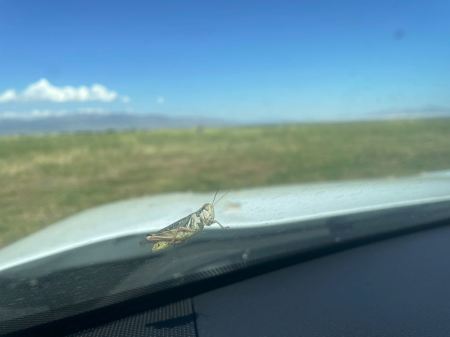National Weather Service blames military 'chaff', not plague of locusts, for Utah radar anomaly

Was a reported grasshopper invasion in Utah not nearly as biblical as it first sounded?
Following several media reports about a large swarm of grasshoppers — also known as locusts — traveling through the state's West Desert area, the U.S. National Weather Service of Salt Lake City, Utah, now says the "swarm" reportedly large enough to be seen on radar was likely military chaff from a nearby Air Force base.
Several local news outlets including NBC affiliate KSL-TV reported "hordes of grasshoppers" were descending on the region, decimating crops and leaving some ranchers concerned.
Toole County rancher Michael Dow told the station over the last couple of weeks, he has seen thousands of the invasive insects on his property, as many as 70 grasshoppers per square yard.
"Every bit of alfalfa that's in my fields is gone," Dow told KSL-TV. "I planted a pasture and all the seedlings were about three-fourths of an inch tall Sunday morning, and on Sunday evening, they were gone, it was bare dirt."
KSL-TV reporter Shelby Lofton tweeted an image of one of the grasshoppers landing on her car windshield.
They immediately landed on my car as soon as I drove into the fields pic.twitter.com/4Y8LeSHQ32
— Shelby Lofton (@newswithShelby) June 30, 2023
"They immediately landed on my car as soon as I drove into the fields," Lofton tweeted.
Dow was quoted as saying the state's Department of Agriculture and Food (UDAF) provided him with poison to take care of the invasion.
A cost-sharing program through the Utah Department of Agriculture provides farmers with pesticide to handle grasshoppers.
The Christian Post reached out Monday to a UDAF spokesperson. This story will be updated with any response.
Nearly a week after the initial reports, however, the National Weather Service clarified that the radar imagery captured and shared by several outlets did not show a "swarm of grasshoppers" but rather something else.
"After further investigation, we've determined that the most likely cause of the signature on 6/21 was chaff originating from Nellis Air Force Base in Nevada," the NWS stated in a July 8 post.
Chaff, according to the NWS, is a "reflective substance that the military can deploy to confuse missile radars, along with weather radars like the ones from the NWS.
The agency appeared to recognize an earlier response to a question about the image.
"We apologize for the error when we were originally asked about this, as the appearance of insects and chaff can have some similar characteristics, which lead to the error in the original analysis," stated the post.
Grasshopper and locust invasions always tend to evoke both the Biblical plagues of Egypt and what many believe is the End Times invasion depicted in Revelation 9, when hideous, locust-like creatures with wings will torture mankind with pain and suffering:
"Then locusts came from the smoke and descended on the earth, and they were given power to sting like scorpions. They were told not to harm the grass or plants or trees, but only the people who did not have the seal of God on their foreheads. They were told not to kill them but to torture them for five months with pain like the pain of a scorpion sting. In those days, people will seek death but will not find it. They will long to die, but death will flee from them!"
Ian M. Giatti is a reporter for The Christian Post and the author of BACKWARDS DAD: a children's book for grownups. He can be reached at: [email protected].





















